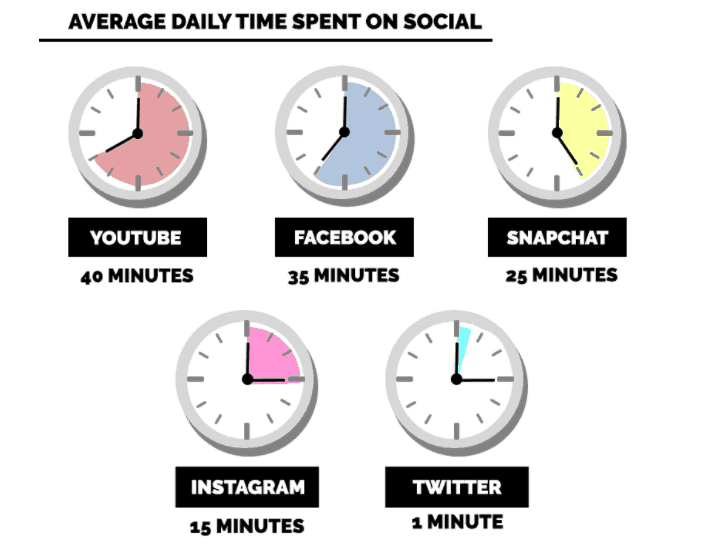
When it comes to social media, choosing a platform on which to advertise can be daunting, as we’ve discussed in our previous article. However, when it comes to recruiting volunteers for a study, there are some social media platforms that make more sense than others. And that is because of two main elements: the number of people on the platform and the available targeting options.
When targeting volunteers that are likely to participate in your study, you want to start with a platform on which there are a lot of people, in order to get the best possible reach. The more people and the more variety of people, the better chance of recruiting successfully via social media.
You also want a platform that has advanced targeting options. If the platform you are using boasts a high number of people and has advanced targeting options, then you have more chances of reaching the right kind of people. Advanced targeting options include location-based targeting, interest-based targeting, and specific demographic-based targeting.
In this article, we’re going to tell you why Facebook (and by extension, Instagram) is our preferred social media platform of choice for recruitment, and why it is much more effective than other platforms.
Why Facebook?
Facebook embodies the 80/20 rule of the social media world—you can get 80% of the results via social media advertising by just using Facebook when it comes to recruitment.
Think about the search engine you use the most—in all likelihood, it is probably Google. However, other search engines like Bing or Yahoo still exist, and people still use them. But the bulk of online traffic always comes from Google.
It is a similar situation when it comes to Facebook versus other social media platforms—sure, there are a lot of other social media platforms out there, but out of all the available social media platforms, Facebook is easily the most ubiquitous.
(Also, because Instagram is owned by Facebook and advertising on Instagram is also performed through the Facebook advertising platform, any mention of Facebook in this article also applies to Instagram.)
Not only does Facebook boast the highest number of users than other social media platforms, but Facebook also has the best targeting and reporting options. So, let’s delve into why that is!
Number of Users
The more users on a specific social media platform, the better your chances of reaching your enrollment goals via that platform.
A large number of people is one of those features in which Facebook dominates all social media platforms. Here’s a quick rundown of the most popular social media websites (worldwide) based on number of users per platform:

Source: https://www.statista.com/statistics/272014/global-social-networks-ranked-by-number-of-users/
Even though YouTube is in second place, it doesn’t even come close to the number of users on Facebook. And then in third, fourth, and fifth place, you have messaging platforms on which you cannot advertise. (Not to mention that two of those platforms—Facebook Messenger and WhatsApp—are owned by Facebook).
More users also means better access to a variety of people, which heightens your chances of reaching your recruitment goals.
Variety
When it comes to recruitment, you want the most number of people possible; however, you also want the biggest variety of people.
The problem when trying to recruit volunteers via other platforms is not only number of users, but also niche users. When it comes to platforms like Pinterest, for example, user demographics are very specific. When you’re targeting users on Pinterest, you’re targeting them based on very specific, niche interests like home decor, fashion, or recipes—those types of interests are mostly irrelevant when it comes to targeting someone for a clinical trial.
Similarly on platforms like LinkedIn or Twitter (platforms that are largely based on professional connections), the niche user base makes it difficult to target potential volunteers for clinical trials. Twitter is great for building relationships with consumers, networking with industry professionals, or for attending to customers’ specific needs (e.g. customer service). LinkedIn is great for building professional relationships. However, neither of these platforms boast as many users and variety as Facebook.
Because Facebook is a general social platform and anyone can use it, you get a large number and a large variety of people, and that makes it ideal for many different types of studies—it also makes it easier to achieve a representative sample.
Targeting Options
When it comes to audience targeting options, Facebook and Instagram provide the most available targeting options, and focus on all the data contained within a user’s personal profile, as well as the people and groups they interact with.
This means that you can narrow down your audience by location, age, gender, or other relevant demographics, which most other social media platforms won’t let you do (or do poorly).
For example, platforms like Twitter and LinkedIn provide opportunities for targeting based on keywords, user handles, hashtags, and conversations happening within the networks. But these targeting options are less than optimal for recruiting patients, especially with specific demographics.
Finding specific people with interests in diabetic diets, for example, simply based on their handles or hashtags would prove quite difficult—it’s much more straightforward to hone in on someone’s specific interests, and Facebook and Instagram allow you to do that quite well.
Below, we’ll explore some of the available targeting options and how they differ between social media platforms.
Mobile Users
The time spent on mobile devices in the United States is now significantly higher (51%) compared to desktop (42%). Which means that when it comes to recruitment via social media, it is extremely important to use a social media platform that has a large number of mobile users and good mobile targeting options.
Unsurprisingly, when it comes to the most popular social media platform accessed via mobile devices, Facebook maintains its popularity—there are over 1.3 billion people using Facebook on mobile devices, worldwide:

https://www.statista.com/statistics/380542/number-of-mobile-facebook-users-worldwide/
In fact, Facebook has more mobile users than Twitter, LinkedIn, and Pinterest have overall users (both on desktop and mobile).
With over 2 billion users on desktop and over 1.3 billion on mobile, Facebook is the social media platform that boasts the highest number of users worldwide.
Location
Most social media platforms will give you the option to target users by specific locations. However, due to the limited number of users on platforms like Twitter, LinkedIn, or Pinterest, Facebook remains your best bet—because of its large number of users, it is much easier to recruit a larger number people located geographically close to the location of your study visits via Facebook.
Demographics
Again, most platforms will allow you to target users by their specific age or gender. However, because of its large user base, Facebook is still the best option—because of the sheer number of people, you will always reach the highest possible number of users.
If you’re looking to recruit specific demographics that are popular on platforms like LinkedIn (e.g. males aged 30 to 64) or Pinterest (e.g. females aged 25 to 34), you could potentially advertise there.
However, remember that you cannot target specific health interests easily on these platforms—so you would not know the specifics regarding who you are targeting. For example, if you are looking for diabetic males aged 30 to 64, LinkedIn would not be able to tell you which users have interests related to diabetes. However, because of its ubiquity and advanced targeting options, Facebook knows whether specific users have joined a diabetes group, or whether they liked a diabetes-related page, which makes targeting these demographics a lot easier.
Interests
Any social media platform with an advertising offering allows you to target an audience by interest (such as clinical trial advertising). However, what makes the most difference, is the type of demographics within each platform, and the types of interests available within the platform.
The higher the number of users on a specific platform, the more varied the interest targeting can get. For example, we mentioned Pinterest earlier, and its very specific interest targeting based on its very specific user base—a platform like that would not be well-suited for clinical trial recruitment.
The same goes for LinkedIn or Twitter—because of their low number of users (compared to Facebook), the number and variety of interests associated with specific users is limited.
Because of the high number and variety of users, Facebook boasts the most advanced interest targeting options out of all the other platforms.
Engagement
Out of all the popular social media platforms, Facebook and YouTube come out on top when it comes to average time spent daily by consumers. So, in addition to not having as many users on other platforms, people don’t engage with other platforms as much.

Source: https://www.socialmediatoday.com/marketing/how-much-time-do-people-spend-social-media-infographic
Having good engagement on a platform means that out of an entire day, you have the most chances to capture someone’s attention through advertising on that platform. And while Facebook only offers you the second-best window for engagement after YouTube, it is still the most efficient and cost-effective option.
Advertising on YouTube is a bit more pricey than advertising on Facebook. For one, video production is a lot more costly than creating a simple Facebook ad—hiring a video production company with all the proper equipment and expertise can cost anywhere between $1,000 to $20,000 for a one-minute video. And you won’t even know whether that video is effective, because that cost covers a single ad, without any strategy or optimisation.
On top of production costs, YouTube allows users to skip ads on their videos, which makes it difficult to engage with the right users in a short amount of time. So, if you need to recruit quickly and effectively, Facebook is definitely the better, tried-and-true option.
Advanced Reporting
Considering Facebook provides you with the most and best available targeting options, it also has the best algorithm and reporting available, to ensure that you are continuously targeting the right people. Once you set up the proper reporting infrastructure, the Facebook algorithm is very good at displaying its ads to people who are more likely to respond.
For example, once you have defined what constitutes a “conversion” (e.g. someone that completes and passes an online prescreen questionnaire), Facebook will focus its advertising on people who are more likely to pass the prescreening questionnaire, as opposed to people who would sign up but fail the prescreening.
We’ve used Facebook and Instagram interchangeably in this article, and that is because the two platforms are linked. While not as good as a platform for recruitment as Facebook, Instagram is a good platform to consider, as it is an option within Facebook targeting itself.
Instagram is more popular with younger demographics, so it works well for recruiting ages 13 to 18. However, you can set up a campaign that targets both Facebook and Instagram within a single campaign, which is very easy and efficient.
Strength in Numbers
The moral of the story when it comes to choosing a social media platform for clinical trial recruitment is that there is strength in numbers.
The more people on a social media platform, the more variety of people, and thus the more available targeting options. Which is why Facebook is so hard to beat when it comes to advertising: it has a high number and a variety of people, as well as the advanced targeting that make it the best option for social media recruitment.
If you’re still unsure on how to get started with Facebook or social media advertising, we have a whole series of articles coming up on how to advertise on social media! However, if you’re pressed for time for your trial, you can just ask the experts directly.



